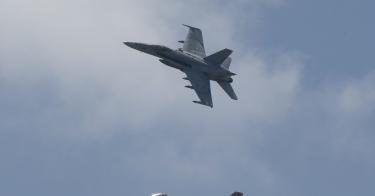In the movie “Top Gun,” the lead character and naval aviator “Maverick” famously says, “I feel the need… the need for speed.” While that might have passed when he was flying the 1,800+ mile range F-14 Tomcat with 100-mile long-range air-to-air AIM-54 Phoenix missiles, speed alone doesn’t work today.
Maverick would now still feel the “need,” but he would need to feel the need for range to survive in a modern war with China. The Navy’s 6th generation carrier-based attack fighter (F/A-XX) will need to embrace both speed and range if future Mavericks are to prevail in combat.
China fields air-to-air missiles like the PL-17 with a range of almost 250 miles. The longest-range air-to-air missile in the U.S. inventory is the AIM-120D with a reported range of approximately 110 miles. There are reports of a new missile in development—the AIM-174B, with a range more on par with China’s PL-17. This air-to-air missile gap may be closing, but conducting strike missions from a carrier outside Chinese weapons range is another challenge.
>>> America’s Navy Is Falling Behind. This Plan Could Fix It
Today, China fields anti-ship ballistic missiles like the DF-21D capable of targeting an aircraft carrier almost 1,000 miles from China, well into the Philippine Sea. Closing on the enemy for strikes without risking the carrier means the next-generation carrier strike fighter (F/A-XX) will need range. Given the need to proceed rapidly to targets, the unrefueled range needs to be well over 1,500 miles.
Launching those strikes from outside China’s air defense is also a must, and means its strike weapons need range, too. These weapons will need to be launched outside the range of Chinese air defenses, such as the land-based and naval HQ-9B, which has a range of over 155 miles. The need for longer-range air-launched strike weapons means they will be bigger, making the aircraft carrying them bigger too.
As such, the F/A-XX will be huge, but still capable of being deployed from aircraft carriers. The F-14 for these same reasons was also very large. It needed to be able to carry its advanced AWG-9 radar to use those long-range AIM-54s and fly at Mach 2.34 (the F-35C carrier variant tops out at Mach 1.6).
The modern battlefield makes today’s mainstay carrier F/A-18s vulnerable and unable to out-stick the Chinese where it matters in range. And the F-35C’s advantage is its stealth, which limits its weapons load—likely unable to carry the long-range air-to-air and strike weapons envisioned in its internal bays.
What’s needed is a fast, long-range, heavily armed strike fighter to suppress the air and surface threats to the carrier, thereby clearing the way for follow-on strikes by F-35Cs, future carrier-based drones, and even legacy F-18s still in service.
>>> Modernizing America’s Nuclear Arsenal
Fifth-generation F-35C fighters entered naval service in 2019, the F/A-18 in 1983—delivering a sixth-generation carrier-based aircraft, while it matters, requires action today. Sadly, the Department of Defense is putting the F/A-XX on life support with $74 million in developmental monies. The Navy is requesting reconsideration of $1.4 billion in an unfunded priorities request.
Given the dangers of today, there are no cheap solutions. The Air Force needs its F-47, as does the Navy its F-35Cs.
But when fixed airfields become untenable early in the next Pacific war, without the range and capacity of an F/A-XX to carry long-range weapons, the ability for America to fight back into the first island chain will be more risky than it needs to be.
This piece originally appeared in the National Security Journal




